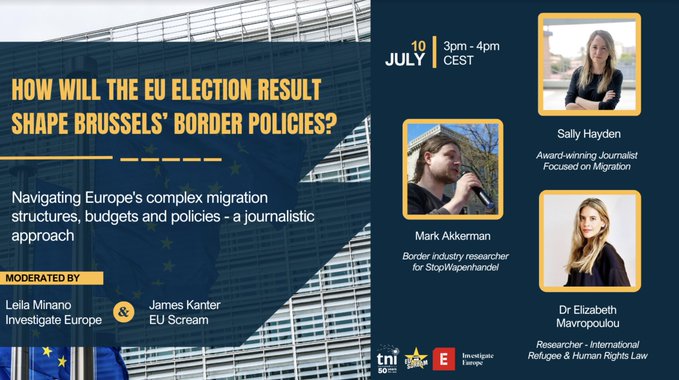
[Presentation at an online migration and asylum workshop for journalists, organised by TNI, EU Scream and Investigate Europe, 10 July 2024] I will try to give a short overview of the most important EU budgets and instruments in the field of border security and control, and identify the key industrial players and their lobby.
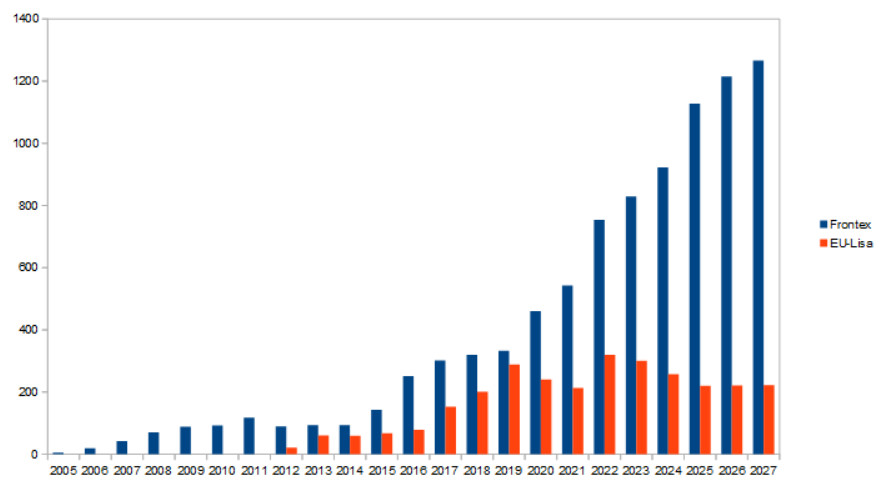
Frontex, the EU border and coast guard agency, has seen an explosive increase in its budgets. Starting in 2005 as a small agency, with the task of coordinating and streamlining member states’ border security efforts, it had a budget of €5.5 million. Under the MFF 2007-2014 its annual budget grew to about €90-100 million a year. With the so-called ‘refugee crisis’ of 2015 a steep increase started, first mostly on an ad-hoc basis as stopping migration remained high on the EU’s political agenda. Under the current MFF Frontex has been given another spending boost, with this years budget of €922 million, increasing to €1.27 billion in 2027. This means a budget that is 66 times as high as in its first full operational year, 2006.
This budget increase accompanies an expending mandate and organisation. Frontex is building its own armed standing border guard corps and is buying its own equipment for border control and patrol, where it used to be completely dependent on contributions of personnel and equipment by member states.
Eu-LISA, the EU Agency for the Operational Management of Large-Scale IT Systems in the Area of Freedom, Security and Justice, operates the systems for border and migration management, in particular several, increasingly connected, biometrics databases, such as Eurodac, the Schengen Information System and the Entry/Exit System. Much of its budget, which is roughly between €200 and 300 million a year, is spend on large longrunning contracts with IT companies.
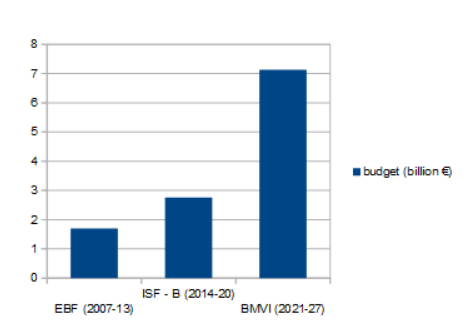
Most of the other EU instruments for border security and control objectives provide funds to member states to strengthen their efforts in these areas, sometimes combined with funding for actions on union level. The main fund for this is the Border Management and Visa Instrument of the Integrated Border Management Fund. Its budget of €7.13 billion, which has seen several increases in the course of the current MFF, is significantly higher than that of its predecessors: the External Borders Fund (2007-13) had a budget of €1.7 billion, the Internal Security Fund – Borders and Visa (2014-20) one of €2.76 billion.
Money from this fund can be used for a wide variety of actions, including the purchase of equipment, setting up large-scale it systems, construction of infrastructure, training and studies. It is often hard to determine where this money is actually going. According to a recent study by PICUM and ECRE so far over 70% of the BMVI allocations have gone to equipment, technology and infrastructure. Only 0.04% went to initiatives designed to increase support and assistance to people with vulnerabilities and people wishing to apply for international protection.
The Asylum, Migration and Integration Fund (AMIF) has a broader scope, as its name suggests, but it does include some funding for detention and deportation activities and support.
In the midterm review process the European Commission, supported by the Council, has proposed to increase the budget heading ‘Migration ‘ with €2 billion, of which €1 billion to the BMVI and €0.8 billion to AMIF. I think you can assume a lot of this will be going towards the implementation of the Pact on Migration and Asylum.
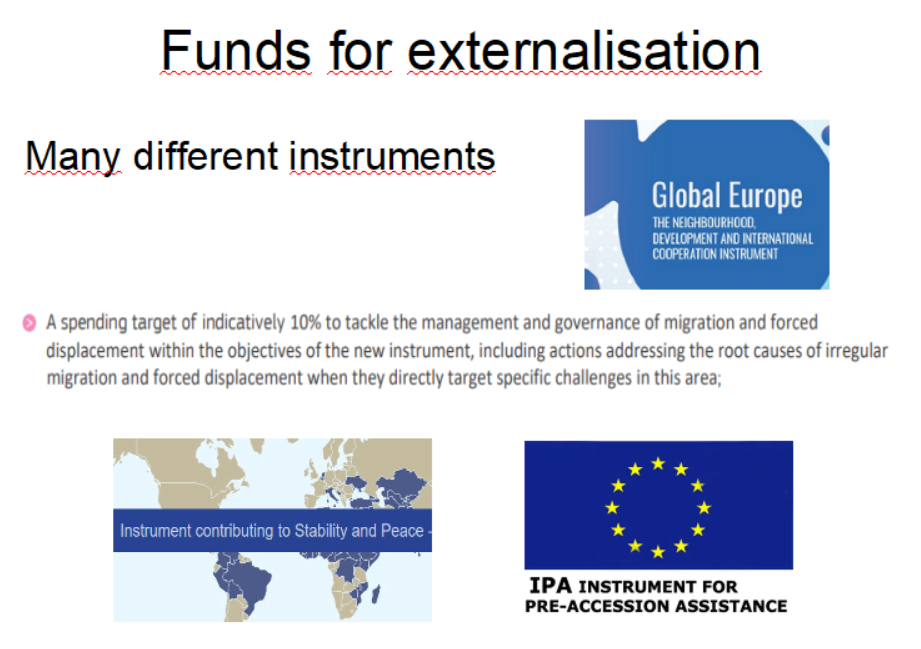
Spending for EU’s border externalisation efforts, to support border security and control in non-EU-countries, is notoriously spread amongst many different instruments, making it hard to get a total overview. Under the current MFF the majority of the regular funding for this comes from the Neighbourhood, Development and International Cooperation instrument – Global Europe, which has a spending target of 10% of its total budget of €79.5 billion for migration management. The mid-term review of the MFF included an additional €7.6 billion for this instrument, aiming at, amongst other things, the “continuation of actions previously undertaken through the EU Trust Fund for Africa.”
Money for externalisation can, however, also come from for example the Instrument contributing to Stability and Peace, the Instrument for Pre-accession Assistance, programs aimed at specific regions, special trust funds and facilities, the IBMF and AMIF, the Frontex budget and a plethora of specific deals with third countries, which can be financed from these instruments or additional union or member states funding. A significant part of all this is used for funding border security and control equipment purchases from third countries or on direct equipment donations.
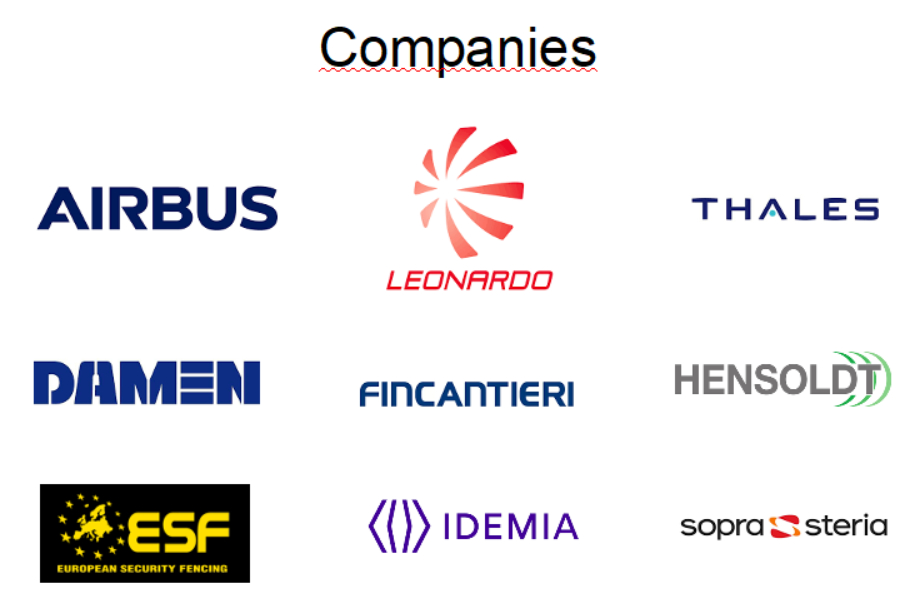
These budgets and their rapid increases have contributed to creating a lucratice border security and control market. For the coming years, market analysis companies estimate growth rates of between 5 and 7% per year, with probably steeper increases for Europe. There are thousands of larger and smaller companies that play a part in the border industrial complex. Main players in the European border security market are foremost the large EU arms companies – Airbus (Transeuropean, mostly French and German), Italian Leonardo and French Thales – that all have broad general military and security portfolios.
Next to that there are more specialised companies, for example ship builders like Fincantieri from Italy and Damen from the Netherlands, that have supplied many border guards with patrol vessels. Hensoldt, which is the result of the sales of the electronics defence division of Airbus, focuses on radar and sensor technology for surveillance. The Spanish European Security Fencing is one of the few producers of concertinas of barbed wire, which are placed on many border walls and fences. Idemia and Sopra Steria, both multinationals with French roots, are among the most important beneficiaries of the large EU contracts for biometric databases.
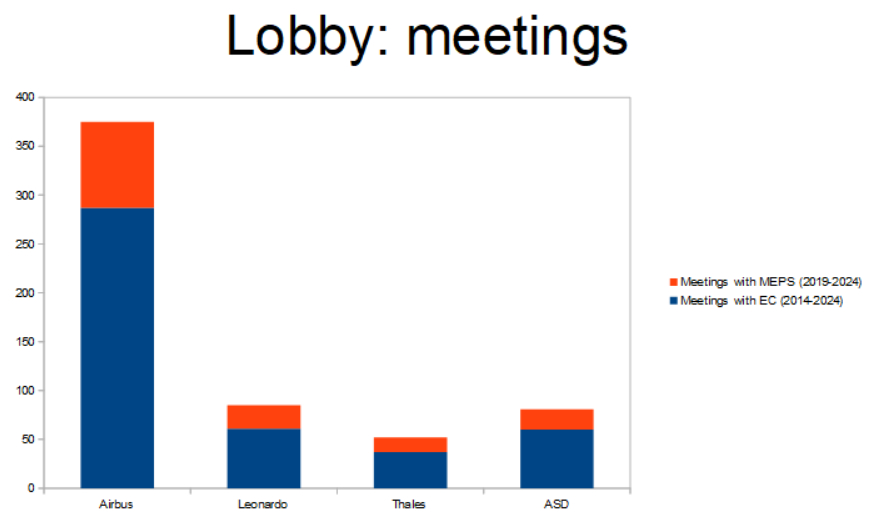
One of the key features of the EU border industry is that it is highly effective in influencing policy. Companies put a lot of effort into is, they have plenty of meetings with the European Commission and with MEPs for example. Not all of these are about border, or broader security and military issues, but they all contribute to the increasingly close relationship between authorities and industry. Next to this, there are many more meetings at arms and security fairs, roundtables and conferences, while the industry also publishes influential policy proposals and conducts effective media campaigns.
In many cases the lobby from the industry side is embraced by authorities, who tend to see company representatives as experts on border and migration issues rather than lobbyists that are predominantly striving for their company’s interests and profits.
As a result, several of the key steps in the development of the EU’s border and migration policies, such as the expansion of the mandate of Frontex, have fundamental elements that can be traced back to earlier industry proposals.
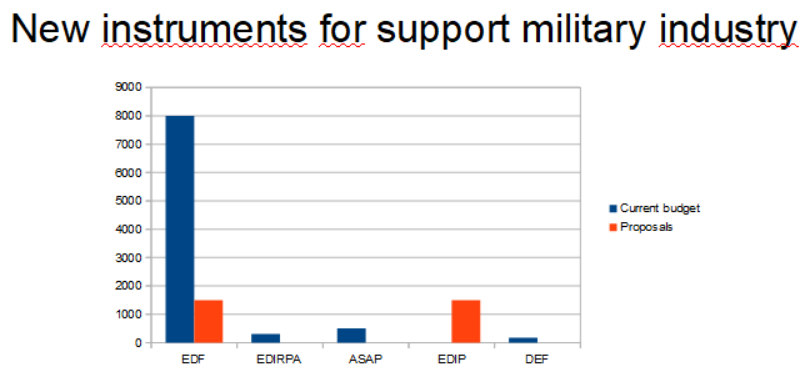
In general there is a lot of support for the European arms industry now, as part of the rapid militarisation of Europe and the sharp increases in military spending. Through various EU instruments the EU channels billions of euros to the industry under this MFF. Meanwhile arms export regulations are weakened and/or pushed aside to help achieve the actual main goal of these instruments: strengthening the international competitiveness of the EU arms industry, or in other words: more arms exports to countries outside the EU.
This will likely have consequences in the area of migration as well: there is a high risk that more EU arms exports, under more permissive export rules, will contribute to war, armed conflict, repression and human rights violations around the world and thereby increase reasons that force people to flee. In the same sense it will allow for easier exports to authoritarian regimes in the context of migration deals with the EU or one or more member states.
To conclude: a quick look ahead. As said, there is a proposal to increase budgets for the remainder of this MFF. I think the proposal for a new MFF will again include larger budgets for border security and control, as the EU is firmly stuck in its one-sided discourse regarding migration. The further shift to the right will undoubtledy result in more anti-immigration sentiments and stricter policies, though it remains to be seen if this will play out mostly on EU level or, with the far right’s often equally dominant anti-EU stances, will take place more on national levels of member states. In any case, where there might be differences and arguments about the implementation of migration and border policies, in particular about responsibilities of member states, there is much agreement on cooperation with non-EU-countries. The trend toward externalisation will likely prevail, deals with non-EU-countries will remain high on the agenda. On the other hand, the increasingly close ties between authorities and the military and security industry and the growth in financial support to arms companies, mostly due to the increases in military spending, will continue to foster the influence of this industry on EU and national policies.